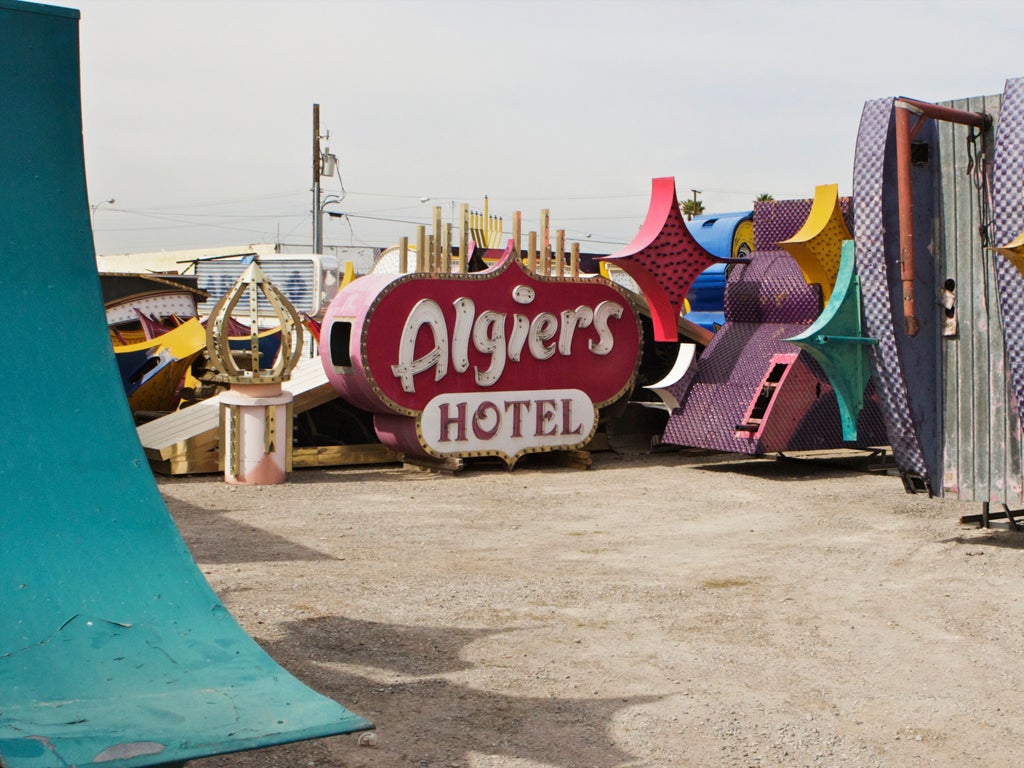Neon dreams live on in Las Vegas
It's the city that never stands still, but Simon Calder finds that the bright lights remain as warm as ever

Blink, and Las Vegas changes. The city constantly reinvents itself. "Old" buildings that have occupied the same block for a few decades are routinely imploded, then replaced by bigger, brighter temptations. Given the perpetual renaissance, the essence of Las Vegas has always been elusive. But if you want to see the famous bright lights, you're in luck – always a good state to be in when you find yourself in the gambling capital of the world.
The 21st-century commercial art that put the Nevada city on the map has finally found a place to call home. The Neon Museum, celebrating the signage of the 20th-century, was born in 1996 – but has only just found a permanent home, within the shapely curves of the lobby of La Concha Motel. This mid-century masterpiece, seemingly sculpted from wedding cake icing, is part of the Las Vegas look that seduced California, Arizona and all states to Maine. But that was several regenerations ago. The seashell-shaped motel itself was saved from destruction in 2005, and moved painstakingly to its new location at 770 North Las Vegas Boulevard.
The "North" is significant: previously, there was no good reason to venture north of the Interstate 515 overpass. Las Vegas Boulevard, the sparkliest street on the planet for most of its course, runs out of steam when it reaches Bonanza Road. Now, however, the city's backstory is on display at the museum's Neon Boneyard ("boneyard" is American for scrap heap). The signs are auspicious.
And what signs they are: more than 150 neon emblems (the largest such collection in the world, you are assured) have been rescued and installed out-of-doors on a two-acre site. The capitals of the Frontier are in bold contrast to the faux Casablanca lettering announcing the Sahara, complete with a pair of camels setting off in opposite directions. Guests are guided around the Neon Boneyard, but before your tour you should dwell in the Visitors' Center to reflect on the dazzling success of the city.
Who put the gas in Las Vegas? Not Frank Sinatra, nor Elvis Presley, but Georges Claude. He was the Parisian engineer who pioneered the liquefaction of air – whose by-products included the elements at the extreme right of the periodic table. Most of the time helium, neon, argon, krypton and xenon do precisely nothing. They are trace elements without a trace of personality. But when Monsieur Claude first thought to put them in a glass tube and added an electric charge, the results were shockingly impressive.
Fired up, helium radiates a lurid magnolia; neon glows red; argon, with a little mercury mixed in, turns bright blue; krypton issues a steely silver; while xenon emits the palest blue. These elementary truths helped Las Vegas find its place in the world. As for Georges Claude: he enjoyed the limelight, but then dabbled in the extreme right once more when he became a collaborator during the Nazi occupation of France, and was jailed in 1945.
Paris first came to Las Vegas a decade later when the Moulin Rouge opened on Bonanza Road. "The resort wonder of the world," as its sign proclaims, set the modern pattern as the original hotel-casino. It was also the first casino in which black people were allowed as guests. By the 21st century, the Moulin Rouge had become a dowdy shell, but at least its signature survives at the Neon Boneyard.
One thing is missing in the boneyard: the chance to see the signs as night intended them. Fortunately, the length of Fremont Street remains a highly-charged gallery. Warm up going south along Las Vegas Boulevard (classed as a "National Scenic Byway") past the Society Cleaners sign topped by a top hat; the Bow & Arrow Motel, promising TVs; and the boast that "Elvis Slept Here" attached to the Normandie Motel. "No vacancies" mourns the subtitle.
Fremont Street, the artery of downtown Las Vegas, was where the first sign was installed in 1929. Today it is an indoor/outdoor gallery of neon, best viewed at dusk or beyond. At the eastern end, be dazzled by a scarlet slipper and a jaunty cocktail – plus the horse and rider sign from the Hacienda, now frozen in mid-leap at the corner of Las Vegas Boulevard.
West from here, you enter the covered "Fremont Street Experience", with a free son-et-lumiere every hour in the evenings that peels back the decades: if you can remember the Sixties, you weren't there, but "Time of the Season" by the Zombies will take you there. The luminations from the neon relics scattered on and off Fremont are even more impressive.
Aladdin's Lamp shines. Andy Anderson – the Anderson Dairy mascot – strides along led by a pint of milk, in the general direction of the flame that illuminated The Flame Bar and Grill. The new-found home of neon should ensure that the heritage of Las Vegas has a dazzling future.
The La Concha Visitors' Center and Neon Boneyard are located at 770 Las Vegas Boulevard; bus 113 passes by, and if you have your own car there is adequate parking. The Center opens 9.30am-5.30pm daily except Sunday, admission $15 (£9.50). Forty-five minute tours of the Neon Boneyard start every half-hour, 10am-3.30pm. Book in advance at neonmuseum.org to be certain of a specific time.
For more information, see DiscoverAmerica.com
Join our commenting forum
Join thought-provoking conversations, follow other Independent readers and see their replies
Comments